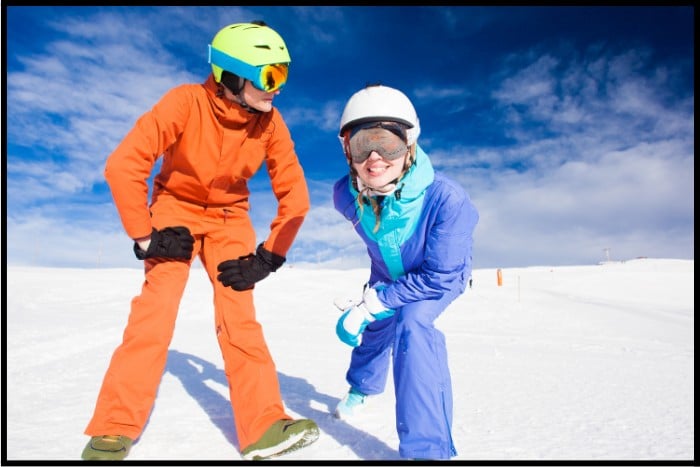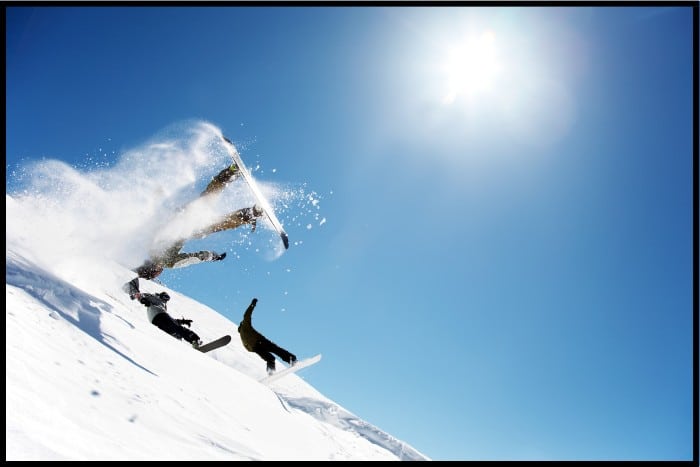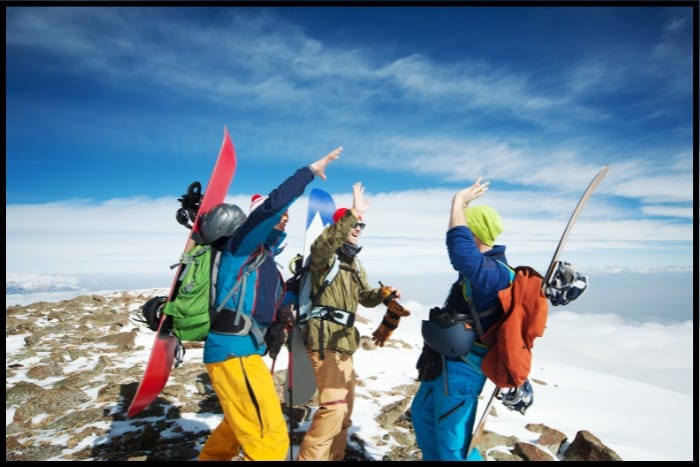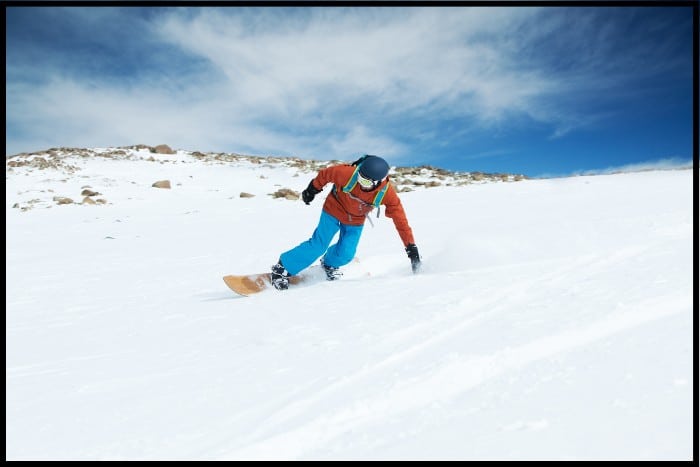While snowboarding has always had a bit of a reputation as a pastime for the rebellious, in reality, you’ll find a community that adheres to its own rules when it comes to keeping the sport safe and enjoyable for everyone.
Whether you’re a beginner or a pro, there are some simple DOs and DON’Ts for snowboarding that never change. Ultimately, these revolve around keeping yourself and others safe on the mountain so you can enjoy your time on the slopes without worrying about the risk of injury impacting your experience.
Today, we will look at what our experienced team considers the most important DO and DON’T rules of the mountain.
Snowboarding DOs
If you’re looking for an enjoyable day on the mountain, be sure to follow these tips.
1. Dress For The Occasion
We get it, decent snowboard gear isn’t cheap, and it’s always tempting to scrimp on a few things.
Still, you’ll regret it once you hit the slopes, as there’s nothing worse than being caught out in the cold without warm, waterproof clothing.
The good news is that if you pick the right clothing and know how to dress for the slopes, you can invest in certain gear while saving money on the rest.
The key to dressing for any outdoor pursuit that exposes you to the elements is layers. Layers give you better control over your temperature by adding or removing them as you see fit.
Opt for a lighter, waterproof, windproof jacket, pants, gloves, and warmer, moisture-wicking under-layers.
As long as your outer layers are high quality, you don’t have to break the bank on under layers as long as you pick the right materials.

2. Wear A Helmet
Fortunately, the days when most snowboarders and skiers refused to wear helmets are mostly in the past.
Sure, some folks still think wearing a beanie is cooler than a helmet, but do you know what’s really uncool? Hitting your head and dying or spending the rest of your life with life-changing disabilities.
You might think we’re being a little dramatic.
Still, the truth is, if you spend a meaningful amount of time in the sport and around the community; eventually, someone you know will end up seriously hurt in a way that could’ve been prevented if they’d worn a helmet.
If you’re a beginner, you’ll fall a lot, and at some point, you’ll hit your head.
Even if you’re a pro, you still only have control over your own board – all it takes is someone else to lose control and take you out, and if you’re not wearing a helmet, your insurance probably won’t cover you.
Buy a helmet rated to US and EU safety standards and wear it. Every. Time. You. Ride.
Check out my best snowboarding helmets in a budget so that you don’t have any excuse for not having one!
3. Check The Weather
Weather up in the mountains can change on a dime. What started as a bluebird day might suddenly become a whiteout where you can barely see more than a handful of yards ahead.
Before heading out for the day, double-check the latest weather reports to know what you’re in for.
Checking the weather means you can pick the right clothing and layers for the wind and temperature, the right goggle lenses for visibility, and even adapt your planned ride to the upcoming conditions.
If you know there’s inclement weather incoming, you can always head for areas of the mountain with better natural cover or trees for protection from the elements, where you can make the most of your day’s riding.
4. Know Your Limits
Knowing your own limits is a critical part of snowboarding when it comes to avoiding catastrophe. Look, we’re not saying you don’t push yourself to improve.
Progression is one of the best parts of snowboarding, but know the difference between advancing your skills and putting yourself at risk.
If you’re comfortable with blue runs, try a few red ones before attempting the double black diamonds.
If you’re getting into freestyle snowboarding, start on the smaller features before hitting the massive kickers in the park.
This advice might sound obvious, but it’s easy to get carried away when the adrenaline is pumping, or you’re riding with more advanced riders and want to keep up.

4. Listen To Your Body And Your Instincts
Snowboarding is a workout. Most estimates reckon you’ll burn an average of 450 calories per hour while riding, and if you’re new to the sport, you’ll be using muscles you didn’t even know you had.
When you’re tired, you’ll make mistakes, and when it comes to snowboarding, it doesn’t take much for a small mistake to translate into a big fall.
It’s always better to listen to your body and call it a day early rather than push yourself and end up injured.
The same goes for your natural instincts – they’re there for a reason, so listen to them. Eyeing up a particular run or trick, and something feels off? Listen to your gut and skip it.
Snowboarding DON’Ts
If you’re looking for an enjoyable day on the mountain, be sure to follow these tips.
1. Don’t Ignore Mountain Safety Guidance
Sure, some rules are meant to be broken, but this doesn’t apply on the mountain. The signage around the slopes exists for a reason, so ignore it at your peril.
If a section of the mountain is declared a no-go area, don’t assume you know better than the staff, whose job is to protect you and other visitors. If you’re riding off-piste, ensure you have a full avalanche kit.
You should also be aware of and follow all area-specific rules.
If you don’t, the ski patrol can easily boot you from the resort for the sake of other riders, and you won’t be getting a refund for your expensive lift pass.
2. Don’t Ride Alone
While we can make an exception for this if, for example, you’re making a short ride through a well-populated part of the mountain to meet up with your fellow riders, you should generally never ride solo.
If you get hurt and you’re alone on a quiet part of the mountain, it could be a long time, if ever, before help arrives.
This does double for riding off-piste when the risk factor of things like avalanches, crevasses, and tree wells increases exponentially.
Safety aside, there’s always the age-old adage: if you do something rad and nobody’s around to see it, did radness truly occur?

3. Don’t Stop In Blind Spots
The mountain is a shared place, and you should never forget about your fellow riders. Crucially, this means maintaining situational awareness at all times, not just when you’re in motion.
When you need to take a break, never stop in the middle of the slope, and make sure you’re in a place where anyone else coming down the mountain has plenty of time to spot you.
Snowboarders usually get the worst rap for this as it’s harder for us to stand up while stationary most of the time, so we tend to sit down, which makes us tricker to see from a distance.
So, do your part in maintaining the sport’s reputation and ensure you’re out of the way yet visible when at a standstill.
4. Don’t Forget Your Sunscreen
Seasoned snowboarders have probably learned about this one the hard way, but do yourself a favor and slap some SPF 50 sunscreen on your face and neck before you hit the slopes, regardless of the weather, and reapply throughout the day.
Snow is highly reflective, so all the sun’s UV rays bounce off the snow straight at your face throughout the day. If you skip the sunscreen, the best-case scenario is a ridiculous “panda eyes” Google tan.
We’ve seen the worst case before, and let’s just say it involved blisters and a lot of pain.
5. If You’re Experienced, Don’t Forget That You Were A Beginner Once
This one goes back to remembering that the mountain is a shared place and that everyone started out somewhere.
It doesn’t matter if you’re the best rider on the mountain; if you’re on slopes with less-confident riders, give them a wide berth and pass them at a reasonable pace.
Don’t get impatient and fly past them at breakneck speeds – even if you don’t cause an accident, it can negatively impact their riding experience.
If you see someone wipe out, check on them and help them out.
If you see someone struggling to get down the piste, by all means, check to make sure they’re comfortable and can get down the mountain safely.
Be kind, and remember that we were all newbies at one point.

Conclusion
Ultimately, making the most of your snowboarding experience and maintaining the integrity of the sport relies on following these essential DOs and DON’Ts.
Prioritize safety and comfort with proper attire, safety gear, and respecting mountain rules, be mindful of your limits and fellow riders, and foster a positive and inclusive environment.
